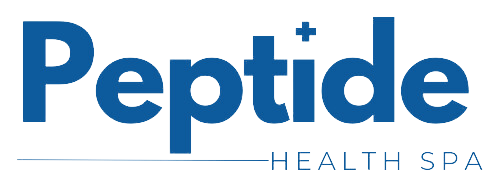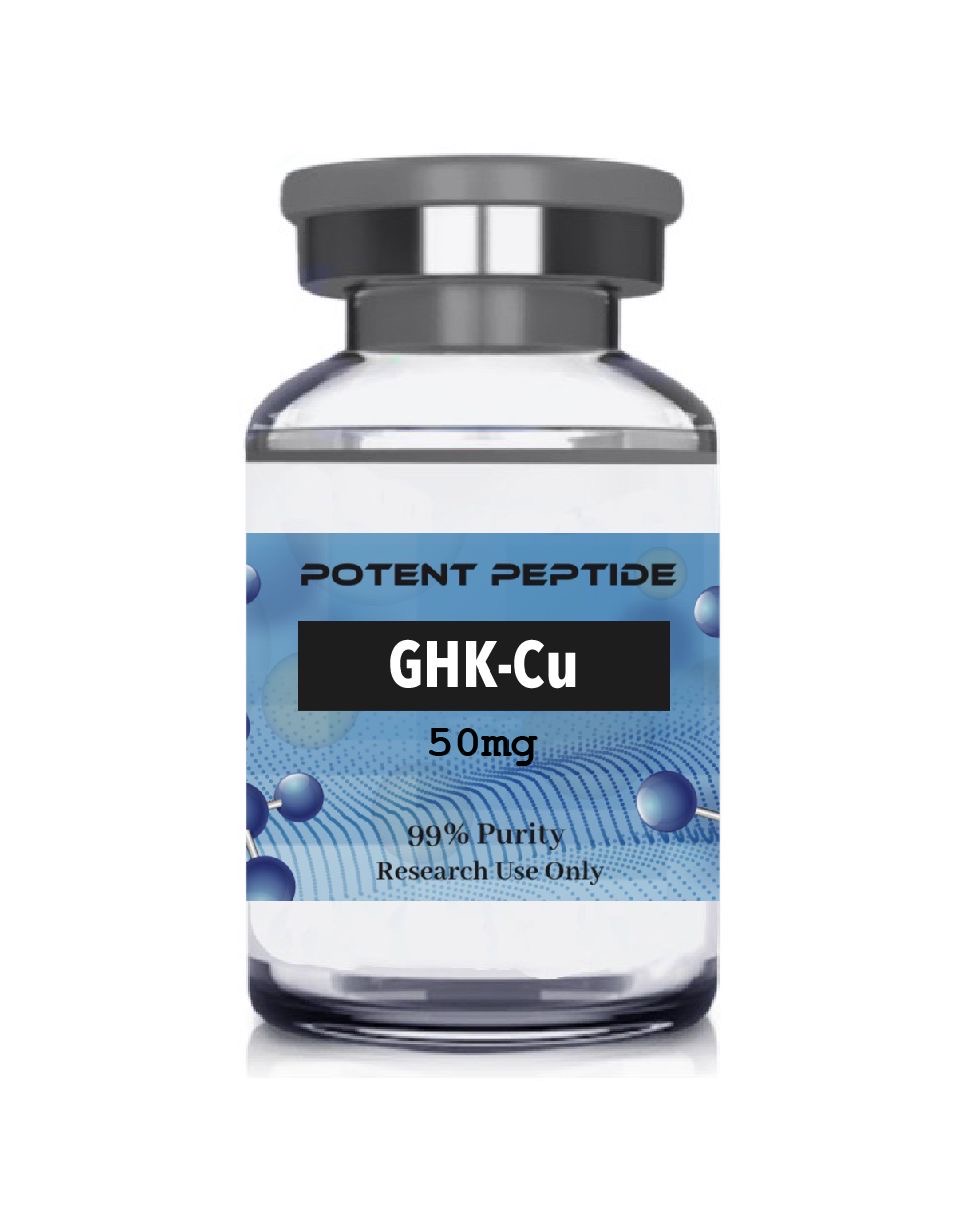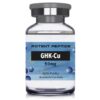Description
GHK Basic Peptide
GHK is a copper peptide that occurs naturally in a copper complex of the tripeptide glycyl-L-histidyl-L-lysine. It has two variants — GHK with or without Cu. GHK appears to have a strong affinity for copper (II), and it is synthesized naturally from plasma, although it has been isolated in other areas. In cases of injury, GHK may be released from tissue cells. The copper peptide appears to affect genes that control an organism’s response to injury and stress. Its functions appear to include the following: tissue remodeling, anti-inflammatory response, pain perception inhibition, nootropic, anti-cancer action, blood vessel growth, and nerve outgrowth. A decrease in the regenerative capacity of an organism may be traced to a decline in GHK-level. Its potential functions extend to infection control, follicle growth, increase in collagen and elastin production, tissue repairing, and synthesis of glycosaminoglycan. Endogenous GHK production is considered to decline over time. [1]
GHK Basic and GHK-Cu
GHK has a sequence inherent in SPARC protein and collagen molecules. Copper, on the other hand, is a transitional element of utmost importance to organisms with a cell membrane, extending from microorganisms upwards. Sequel to its conversion from oxidized -Cu (II) to reduced -Cu (I), it is considered to be a vital cofactor in a series of biochemical reactions accompanied by electron transfer. The changes in copper oxidation state may be an advantage, as dozens of enzymes may adopt it in catalyzing critical biochemical reactions such as detoxification, blood clotting, cellular respiration, antioxidant defense, and connective tissue regeneration.[2] Copper also appears to be vital in iron metabolism and embryonic development, potentially essential for most metabolic reactions that occur in fetal development, oxygenation, and other biological processes.
Specifications
MOLECULAR FORMULA: C14H24CuN6O4
MOLECULAR WEIGHT: 403.9242g/mol
SYNONYMS: NSC661251, NSC-661251
Research
GHK PEPTIDE AND CANCER CELLS
Tumor suppressor genes or antioncogenes, growth regulatory-, and DNA repair-genes appear to be essential in cancer cell suppression and angiogenesis (cell death). Following research by Hong et al., the copper peptide may be linked to wound healing and skin remodeling.[4] In one study, two molecules appeared to have reversed the gene expressions of the research models. Subsequently, researchers suggested that they might extend beneficial action in models of metastasis, and conclude that “Gly-His-Lys and securinine could reverse the differential expressions of these genes significantly, suggesting that they have combinatorial therapeutic effect on the metastasis-prone [test subjects].”
GHK ON INSULIN AND INSULIN-LIKE GENES
The insulin family, in minimal amounts, has been suggested to induce a supportive impact on cell function and lifespan, but high levels of insulin and insulin-like proteins may actually hasten angiogenesis. Similarly, the GHK peptide appears to stimulate the production of three genes in this system and may suppress six genes.[6] The gene expression data suggest that GHK suppresses six of nine insulin/IGF-1 receptors. In vitro experiments reported that reduced insulin/IGF-1 signaling due to mutations may decelerate the process of cell aging and lengthen across a multitude of cell types.[7]
GHK AND TISSUE REPAIR
The naturally occurring GHK molecule is considered to play a vital role in the repair of damaged tissues. Endogenous copper peptides are similarly vital, possibly accelerating the production of elastin and collagen proteins. They appear to enhance the production of glycosaminoglycans and hyaluronic acid that aid in moisture retention. The introduction of synthetically developed copper peptide appears to enhance blood flow to areas of focused follicle growth, encouraging hair follicle development. According to Campbell et al., GHK appears to enhance the production of TGF beta and members of the same species that initiate the repair process. The copper peptide, with the aid of TGF beta, may reset the gene expression of fibroblasts in research models of COPD. Campbell et al also “suggest the need for additional studies to examine the mechanisms by which TGF beta and GHK each reverse the gene-expression signature of emphysematous destruction and the effects of this reversal on disease progression.” [3]
GHK AND FIBRINOGEN SYNTHESIS
Fibrinogen is a glycoprotein complex composed of three polypeptide chains: alpha, beta, and gamma. GHK appears to suppress the beta chain of fibrinogen. As a result, inadequate FGB may actively stop fibrinogen synthesis as fibrinogen synthesis depends on equal amounts of the three polypeptide chains. General synthesis of fibrinogen appears to be brought to a halt by the impact of the GHK peptide exerted on the FGB gene & IL-6 production.[5]
GHK PEPTIDE AND DNA REPAIR
At the onset of aging, DNA damage begins to amass. The GHK peptide has been researched in relation to its potential to reset the activity of DNA repair genes, diminishing physiological decline. Studies are ongoing.
GHK PEPTIDE AND ANTIOXIDANT CHARACTERISTICS
GHK appears to initiate 14 antioxidant genes, and may repress two pro-oxidant genes. Pickart et al. propose that the “GHK tripeptide as a possible therapeutic agent against age-associated neurodegeneration and cognitive decline”.[8] As a result, the effects of free radicals and toxic end products such as, atherosclerosis, cancer, cataracts, may possibly be reduced or annulled.
GHK PEPTIDE AND UBIQUITIN/PROTEASOME SYSTEM (UPS)
UPS is considered to abolish damaged proteins. GHK appears to stimulate gene expression in 41 UPS, and suppress only 1 UPS gene. As a result, UPS appears to reduce age-related decline.
Disclaimer: The products mentioned are not intended for human or animal consumption. Research chemicals are intended solely for laboratory experimentation and/or in-vitro testing. Bodily introduction of any sort is strictly prohibited by law. All purchases are limited to licensed researchers and/or qualified professionals. All information shared in this article is for educational purposes only.
References
- Dou Y, Lee A, Zhu L, Morton J, Ladiges W. The potential of GHK as an anti-aging peptide. Aging Pathobiol Ther. 2020 Mar 27;2(1):58-61. doi: 10.31491/apt.2020.03.014. PMID: 35083444; PMCID: PMC8789089.
- Cass AE, Hill HA. Copper proteins and copper enzymes. Ciba Found Symp. 1980;79:71-91. doi: 10.1002/9780470720622.ch5. PMID: 6907091.
- Campbell JD, McDonough JE, Zeskind JE, Hackett TL, Pechkovsky DV, Brandsma CA, Suzuki M, Gosselink JV, Liu G, Alekseyev YO, Xiao J, Zhang X, Hayashi S, Cooper JD, Timens W, Postma DS, Knight DA, Lenburg ME, Hogg JC, Spira A. A gene expression signature of emphysema-related lung destruction and its reversal by the tripeptide GHK. Genome Med. 2012 Aug 31;4(8):67. doi: 10.1186/gm367. PMID: 22937864; PMCID: PMC4064320.
- Hong Y, Downey T, Eu KW, Koh PK, Cheah PY. A ‘metastasis-prone’ signature for early-stage mismatch-repair proficient sporadic colorectal cancer patients and its implications for possible therapeutics. Clin Exp Metastasis. 2010 Feb;27(2):83-90. doi: 10.1007/s10585-010-9305-4. Epub 2010 Feb 9. PMID: 20143136.
- Pickart L, Margolina A. Regenerative and Protective Actions of the GHK-Cu Peptide in the Light of the New Gene Data. Int J Mol Sci. 2018 Jul 7;19(7):1987. doi: 10.3390/ijms19071987. PMID: 29986520; PMCID: PMC6073405.
- Pickart L, Vasquez-Soltero JM, Margolina A. GHK and DNA: resetting the human genome to health. Biomed Res Int. 2014;2014:151479. doi: 10.1155/2014/151479. Epub 2014 Sep 11. PMID: 25302294; PMCID: PMC4180391.
- Vitale G, Pellegrino G, Vollery M, Hofland LJ. ROLE of IGF-1 System in the Modulation of Longevity: Controversies and New Insights From a Centenarians’ Perspective. Front Endocrinol (Lausanne). 2019 Feb 1;10:27. doi: 10.3389/fendo.2019.00027. PMID: 30774624; PMCID: PMC6367275.
- Pickart L, Vasquez-Soltero JM, Margolina A. The human tripeptide GHK-Cu in prevention of oxidative stress and degenerative conditions of aging: implications for cognitive health. Oxid Med Cell Longev. 2012;2012:324832. doi: 10.1155/2012/324832. Epub 2012 May 10. PMID: 22666519; PMCID: PMC3359723.






Reviews
There are no reviews yet.